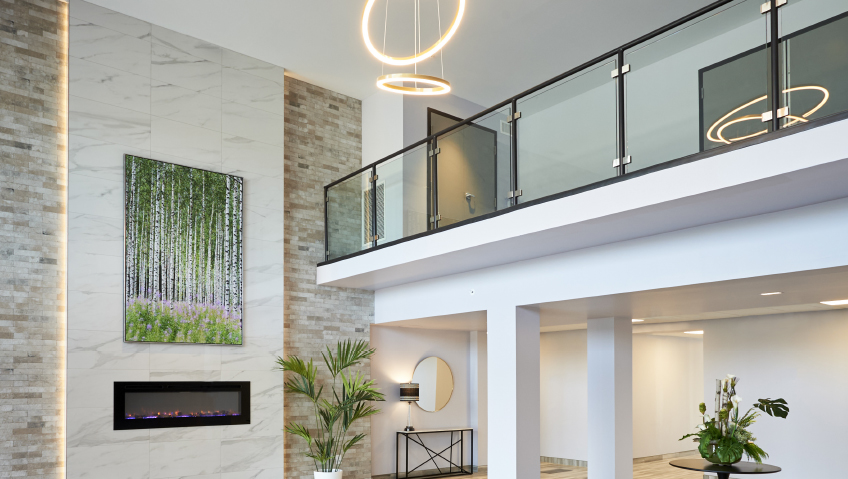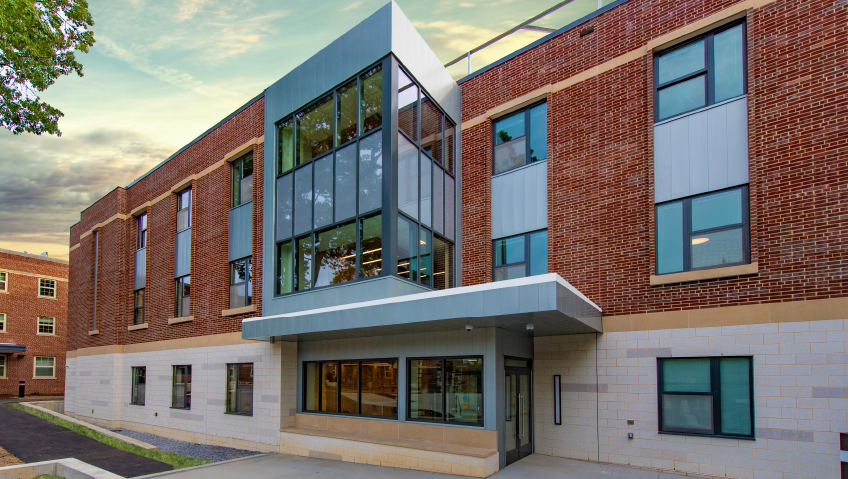A company’s success lies in its talent, passion, and drive, and Reid’s Heritage Construction (RHC) is doing remarkably. For 15 years, this Cambridge, Ontario construction and design management firm has brought its wealth of expertise to sustainable building processes.
Focusing on industrial, commercial, and institutional (ICI) construction in large building development and condos, RHC – previously with a group of companies that included Reid’s Heritage Homes – is now an independent entity working with designers, engineering firms and architects.
RHC is closely affiliated with various co-op programs from local colleges and universities where it mentors, trains, and hires the best and brightest.
Mid-rise sweet spot
“We have ongoing projects from Windsor to Ottawa, most of them focused on purpose-built rentals,” says President Eric Schmidt. “We do a lot of rental and condominium structures, and our company’s sweet spot the last couple of years has been mid-rise type construction.”
This encompasses four- to six-storey buildings, typically using engineered precast concrete hollow core floor systems with non-combustible structures like cold-formed steel (CFS). This wasn’t always the case, however; when RHC first incorporated, its claim to fame was the development of cost-effective mid-rise buildings utilizing total engineered wood structures with precast concrete hollow core floors.
“The entire structure of four to six storeys was framed out of wood panels, and the floor systems were precast concrete,” says Schmidt. “That’s how RHC rose to prominence and created a niche within the ICI industry. Not many people were building total wood structures, especially four to six storeys, and putting in precast concrete slabs.”
The reason for doing so, he says, was two-fold: Because RHC was an experienced home builder, the company used its vast experience with wood frame structures and incorporated it into mid-rise buildings.
“We had a wood panel company at the time that panelized the wood structure, making it more cost-effective and much quicker to assemble,” Schmidt says.
“At the end of the day people look at the value proposition, and unfortunately the value proposition in rental housing is still ‘what’s the price for building?’, ‘what’s the price per door?’ And wood frame structures answered that need.”
Lumber goes stratospheric
Lumber prices skyrocketed, and the underwriting from insurance companies became prohibitively high on wood frame structures, as a result of the fire risks of wood.
“Once a building is completed and is fire rated, there’s no inherent risk of that building burning down versus a non-combustible structure,” Schmidt says. “But during construction there are more fire risks with wood structures, so now we’ve pivoted away from all-wood frame structures to non-combustible structures, primarily CFS.”
RHC employs CFS while still using a precast concrete hollow core floor system, and in some cases it’s doing total precast concrete buildings, top to bottom.
“A lot of buildings are being designed this way because it’s cost-effective, very quick to assemble and you don’t experience winter conditions like you would pouring concrete,” says Schmidt. “There’s also obviously a lot less labour in a precast structure than in cast-in-place structure.”
The company is now doing three total precast concrete structures of 12 storeys in Eastern Ontario. “That’s a big deal for us,” says Schmidt. “That’s the first time we’ve done that many buildings in total precast in one place.”
Long-term care & collaboration
RHC has much experience with long-term care facilities, and the company has just finished a unique project for Revera in London, which took occupancy in October.
“It’s a state-of-the-art facility, a prototype for the future,” Schmidt says. “Revera will be building dozens across the country. It’s shaped almost like a starship, a spoke-and-hub type operational design that allows a care facility – that caters to dementia and Alzheimer’s patients – to make staff and resident movement easier.”
The project was a collaborative design-build with MMMC Architects out of Branford, and involved five different structural materials: CFS, red iron, cast-in-place concrete, wood, and concrete block.
In other collaborative efforts, RHC designs unique purpose-built rentals with various real estate investment trusts, including Skyline, one of the largest private REITs in Canada.
“We’ve built a lot of buildings with Skyline in Ontario over the past four or five years,” says Schmidt. “We collaborate with them in procuring the land, getting the land approved in terms of site plan, designing the buildings in concert with them, including the finishes inside and out.”
This “evolutionary process” has resulted in a specified rental unit standard which includes nine-foot ceilings, luxury vinyl flooring, in-suite laundry, and all-stainless-steel appliances.
The case for amenities
“They’re very spacious, mostly two-bedroom designs that are split by the living room, so you have some privacy if you have a home office,” he says. “As a result of this collaborative effort, we now – rather than having in-building amenities – get sites that allow for three smaller buildings, and we create a huge amenity building outside.”
The amenity centre also houses a gym and a social area and showers, allowing a community to develop for the tenants.
Studies have shown, Schmidt says, if you make one friend in a community, you’re 50 percent less likely to move out, if you make two friends, you’re 75 percent less likely, and if you make three friends you’re never going to move away.
“Of course, that’s one of the things rental companies are concerned about – turnover of their tenants,” adds Schmidt. “If you create a community, there’s less likely to be turnover. The good news is we’re doing more of them, and we’re building bigger amenity buildings because it’s great, and people want it bigger.”
RHC is currently doing three building site designs with large separate amenity buildings in Trenton and Belleville.
“We do a lot of buildings for Skyline following that design principle that makes it a lot more desirable for the tenant,” says Schmidt. “There’s bike storage, lockers, an area where people can wash off their dogs. We’re also putting in EV chargers because people are going to start driving electric vehicles. We’re getting ahead of that and really listening to the customer.”
The reality, says Schmidt, is not everyone can afford a home today, and not everyone wants to go into home ownership. Demographically, Canada is changing to a more European model where home ownership isn’t as desirable as it was previously, and RHC is responding to that desire.
The freedom of renting
“People want freedom, they want a quality of life,” Schmidt says. “You can rent a beautiful building that’s cost effective and gives you that quality of life, and then it gives you freedom because you’re not mowing grass. You can go on your vacations, and you can go and have your hobbies whether it’s cycling, golf or whatever.”
Schmidt adds that here in Canada if you’re mortgage poor, you’re not as likely to be enjoying a leisurely lifestyle.
“When I talk to tenants, they say, I sold my house and I really don’t want to live in a house anymore,” he says. “They like this because they can lock the door and go have hobbies and free time. I think you’re seeing that more and more in Canada.”
Assisting RHC to achieve these goals for clients is a pool of enthusiastic co-op students from local schools including Conestoga College, University of Waterloo, and Laurier University, in fields such as architecture, construction, and civil engineering.
A business of people
“We’re in the backyard where we can access all these resources,” says Schmidt of the company’s happy proximity to all this talent. “Our business is people. We don’t physically build anything. We’re facilitators. As a GC, we facilitate construction, we hire subtrades, engineers, and architects, and we collaborate with them and facilitate the construction of a building design. Our business is really about the power and strength of our people.”
Looking at a cross section of RHC staff, many are former alumni, graduates of Conestoga or one of the universities, says Schmidt. It’s been a “real blessing” to have these people close by, able to access RHC’s co-op program that takes on numerous students each year with the goal of them returning to their studies, graduating, and eventually being hired.
“Some of our best employees are former co-op students,” he adds. “We’re big advocates of the co-op system, and we have a great working relationship with the college. It’s been fantastic.”
RHC’s ongoing diversification includes a strategy to be more regionally and provincially diverse, not dependent on one region or one type of business. While mid-rise condos are still a priority, it’s also looking at data centres, hotels and more long-term care facilities, with an eye to ultimately expanding into the U.S., where Schmidt ran a major corporation for 15 years and developed an appreciation and understanding of the opportunities in various markets.
A rewarding career
When it comes to challenges, Schmidt knows all companies face retention and turnover issues, but he believes RHC has successfully addressed these head on.
“People don’t leave because of money,” he says. “At the end of the day it may be one of the factors, but it’s not the number one reason people leave. The money is the easy thing to solve. People who ask for more money are never going to stay. It’s because they don’t feel inspired, enriched, appreciated, or challenged. Those are the reasons they leave.”
In short, says Schmidt, people will have a rewarding, fulfilling career working for RHC, where they will grow and thrive.
“The success of a company, if it can be measured, is the sum total of the talent of all the people collectively,” says Schmidt. “It’s not about one individual or three. I’ve helped manage billion-dollar companies, but we probably have the best group of people I’ve worked with in a long time here, probably the most diverse, creative group of people I’ve ever worked with.”
And it’s that diversity and creativity that makes it exciting to come to work, he adds, along with the fact that RHC prides itself on bucking tradition and embracing opportunities.
“If you come into our office, you’ll see a totally different company than you’ll see at our competitors,” he says. “It’s important to recognize opportunity, not just check off a box. There are a lot of talented people who can do the job. We have the best people, we have great diversity, we represent our clients. And we have fun!”






